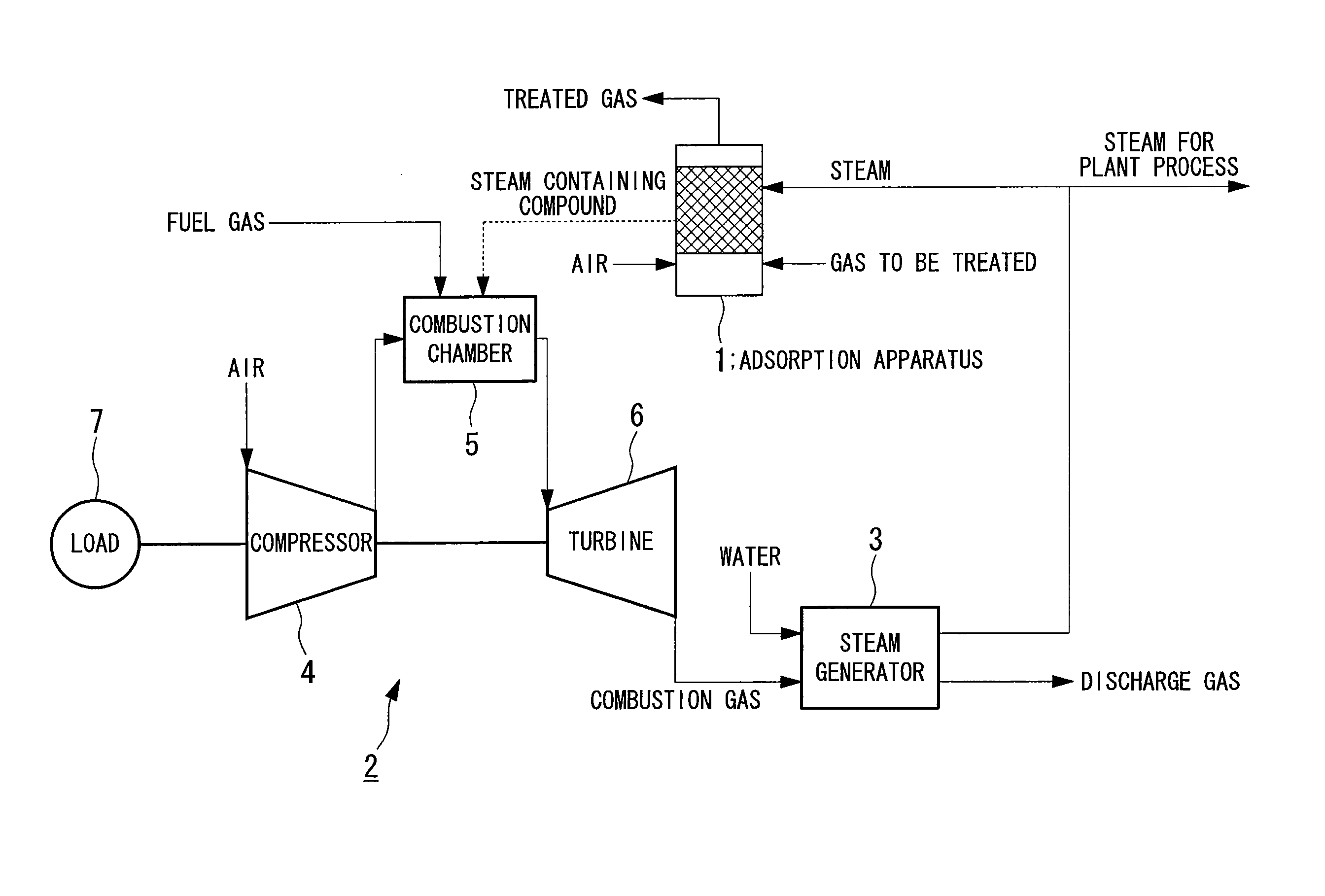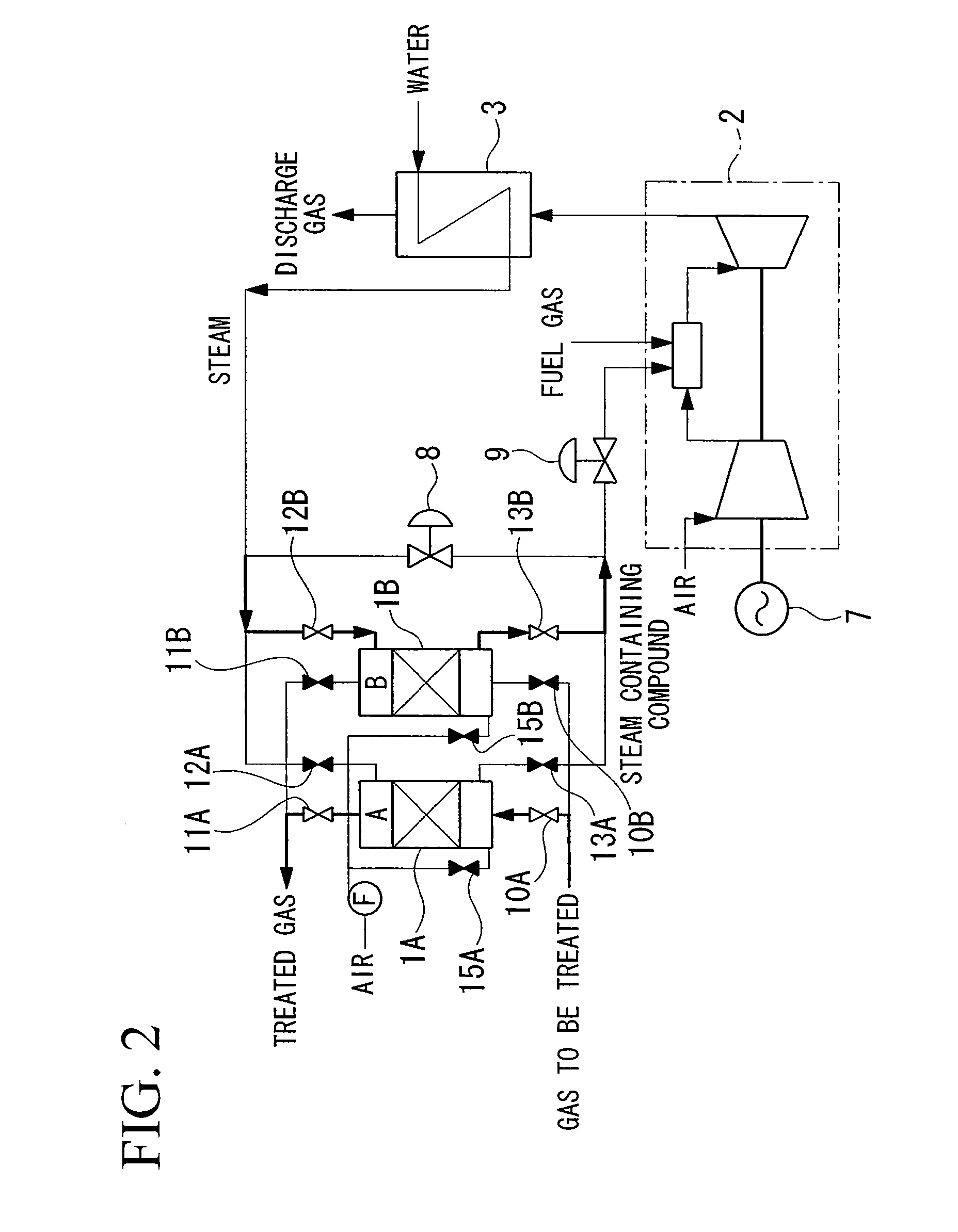Method Of Treating Volatile Organic Compound And System For Treating Volatile Organic Compound Using Gas Turbine
a technology of volatile organic compound and treatment method, which is applied in the direction of machines/engines, combustion types, lighting and heating apparatus, etc., can solve the problems of increasing the cost of operating the facility, and achieve the reduction of the amount of nox in the combustion gas discharged from the gas turbine, the effect of improving overall energy efficiency and suppressing the effect of nox
- Summary
- Abstract
- Description
- Claims
- Application Information
AI Technical Summary
Benefits of technology
Problems solved by technology
Method used
Image
Examples
first embodiment
[0049]FIG. 1 is a system block diagram showing a characteristic configuration of a volatile organic compound treatment system according to a first embodiment of the present invention. In FIG. 1, reference symbol 1 denotes an adsorption apparatus, 2 denotes a gas turbine, and 3 denotes a steam generator.
[0050] The adsorption apparatus 1 adsorbs a volatile organic compound contained in a gas to be treated, in an adsorbent thereinside, to thereby remove the volatile organic compound from the gas to be treated, and desorbs the volatile organic compound adsorbed in the adsorbent, using steam under a pressurized environment, and mixes this with steam. For the adsorbent, for example activated carbon is used. Furthermore, the pressurized environment is realized by supplying steam to the adsorption apparatus 1.
[0051] In such an adsorption apparatus 1, the gas to be treated is input from the outside, and together with this, steam is input from the steam generator 3. On the other hand, the t...
second embodiment
[0060] Next is a description of a second embodiment of the present invention, with reference to the system block diagram shown in FIG. 2.
[0061] At first, the quantity of steam that the gas turbine (i.e. the combustion chamber 5) requires for its own drive (the combustion steam quantity), and the quantity of steam that the adsorption apparatus 1 requires for adsorbing the volatile organic compound (the compound adsorption steam quantity), are not necessarily the same. That is, the combustion steam quantity needs to be determined from the requirements for safe and efficient operation of the gas turbine, while the compound adsorption steam quantity needs to be determined from the requirement for effective adsorption of the volatile organic compound.
[0062] In the volatile organic compound treatment system according to the first embodiment, the configuration was such that the steam containing compound discharged from the adsorption apparatus 1 was supplied as is, to the combustion cham...
third embodiment
[0084] Next is a description of a third embodiment of the present invention, with reference to FIG. 6.
[0085] The third embodiment is one which applies pretreatment to the gas to be treated in order to improve the treatment efficiency. FIG. 6 is a system block diagram of a volatile organic compound treatment system according to the third embodiment. Components the same as for the volatile organic compound treatment system according to the first and second embodiments, are denoted by the same reference symbols.
[0086] In FIG. 6, reference symbol 16 denotes a dehumidifying tower, 17 and 20 denote chillers, 18 denotes a concentrator, and 19 denotes a fan. The dehumidifying tower 16 is a tower which dehumidifies the gas to be treated by gas / liquid contact with cold water. That is to say, the dehumidifying tower 16 is constructed so that gas to be treated is supplied from below, and the gas to be treated is discharged from above, while cold water is watered from above to below. Consequen...
PUM
 Login to View More
Login to View More Abstract
Description
Claims
Application Information
 Login to View More
Login to View More - R&D
- Intellectual Property
- Life Sciences
- Materials
- Tech Scout
- Unparalleled Data Quality
- Higher Quality Content
- 60% Fewer Hallucinations
Browse by: Latest US Patents, China's latest patents, Technical Efficacy Thesaurus, Application Domain, Technology Topic, Popular Technical Reports.
© 2025 PatSnap. All rights reserved.Legal|Privacy policy|Modern Slavery Act Transparency Statement|Sitemap|About US| Contact US: help@patsnap.com



